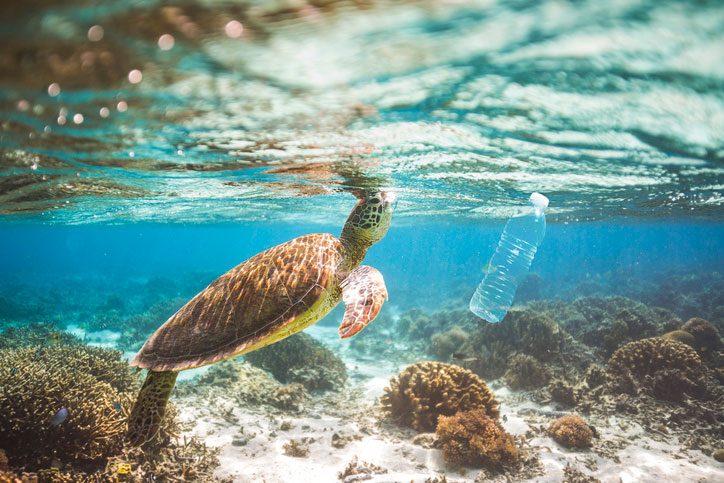

Among the many fields that play a part in the interdisciplinary study of environmental science you’ll find ecology, meteorology, geology, biology, chemistry, and physics. Really, you’d be hard pressed to find any field that brings all the natural sciences together in such a complete and cohesive way.
But in the context of a liberal arts education, that interdisciplinary thinking goes beyond the various scientific disciplines that are involved in understanding the natural world. It includes all the ways humanity affects and is affected by the world we live in. That means you’ll have a chance to look at environmental science through the lens of social science and anthropology, business and commerce, agriculture and food production, and even modern politics.
It’s this kind of perspective that prepares liberal studies graduates to make meaningful contributions in areas that intersect with environmental concerns, including everything from public policy and law, to economics, sociology, urban planning, sustainable development, and a whole lot more.
Sponsored School(s)
The environment is extraordinarily complex, a mix of inter-reliant ecological systems that interact with each other in ways that we have only recently come to fully understand and appreciate. But the natural world also includes the humans that both influence and rely on those systems. This makes environmental science a perfect fit for a liberal arts curriculum where students are encouraged to consider the environment in the context of the human experience.
“One of the first conditions of happiness is that the link between man and nature shall not be broken.”
~ Leo Tolstoy
A Look at the Study of Environmental Science in the Context of a Liberal Arts Education
Environmental science is a multifaceted discipline that studies the physical, chemical, and biological systems of the earth and how they interact with each other. Environmental science seeks to conserve, protect, and restore our environment while balancing the needs of humanity in the face of a changing climate, natural resource depletion, shrinking ecosystems, and a growing population.
A well-rounded liberal arts education isn’t complete without study in environmental science. In fact, it’s safe to say that the very interdisciplinary nature of environmental science exemplifies the liberal arts approach to education.
When we examine the physical world around us enough to understand the interplay between its systems, we realize we’re as much a part of it as anything else. There exists an inherent relationship between humans and the natural world, and from a modern perspective, we realize that the relationship needs to shift in the direction of stewardship.
All the rhetoric and good intentions in the world won’t move the needle. It’s hard science and policy in action that gets the job done.
Studying environmental science allows you to:
- Gain insight into the relationship between people and the environment
- Improve your understanding of the scientific principles related to the environment
- Expand your knowledge of the earth’s ecosystems
- Understand the connection between contemporary environmental issues and policy, ethics, society, and more
- Advocate for the environment
- Gain a deeper understanding into issues and solutions to environmental problems
Why Study Environmental Science? – Addressing the Most Pressing Issues of Our Generation
 Climate Change: Scientists at NASA and the National Oceanic and Atmospheric Administration are telling us that global temperatures the last five years were the warmest on record, creating conditions that endanger many animal species, increase catastrophic weather events, erode shorelines, and threaten the global food supply.
Climate Change: Scientists at NASA and the National Oceanic and Atmospheric Administration are telling us that global temperatures the last five years were the warmest on record, creating conditions that endanger many animal species, increase catastrophic weather events, erode shorelines, and threaten the global food supply.
Ocean Pollution: Oceana, a national advocacy group focused on ocean conservation, tells us nearly 18 billion pounds of plastic enter the oceans every year, impacting our oceans’ delicate ecosystems and threatening to extinguish sea life.
Green Energy Alternatives: It’s a race to find and employ cleaner alternatives to coal and fossil fuels to reduce greenhouse gases and allow nation states to become energy independent.
Drinking Water Safety: The Flint water crisis forced many environmental officials to look at water contamination, improperly tested and treated water, and the introduction of chemicals into the water systems.
The Organizations Doing that Important Work
- Nonprofit organizations: Audubon, Earth Policy Institute, Sierra Club, Oceana
- Governmental agencies and laboratories: National Fish and Wildlife Service, Environmental Protection Agency, National Science Foundation
- Environmental education and outreach agencies: Ecological Society of America, Environmental Literacy Council, North American Association for Environmental Education
- Environmental consulting firms
- Academia
The Environmental Science Courses You Might Find in Your Liberal Studies Curriculum
At the core of this super broad liberal arts discipline is the study of biological environmental science and physical environmental science. Your liberal studies curriculum will start by helping you establish a solid foothold in the biological and physical sciences:
Biological environmental science: Biological environmental science involves all the moving parts of our natural environmental systems, working to answer the question: How do humans interact with their physical environment?
Physical environmental science: Physical environmental science looks at all the processes – infinitesimally small to massive – that shape our physical environment. Soil formation, rock formation, water cycling, and more—it’s all part of physical environmental science.
From there, your environmental science coursework opens up plenty of doors for in-depth study in areas like:
Atmospheric Sciences
Atmospheric sciences study the earth’s atmosphere and how it relates to the environment. All of the processes that occur within our environment have an impact on it, so understanding atmospheric sciences is vital to better understanding – and combatting – climate change.
Ecology
Ecology looks at how all the living organisms on earth interact with each other. Therefore, the study of ecology includes an examination of how humans, plants, and animals all influence one another.
Environmental Chemistry
Environmental chemistry analyzes chemical processes and how they affect the environment. Many of the processes studied in environmental science are related to water pollution, soil contamination, and the overall degradation to our environment that occurs as a result of chemical processes.
Geosciences/Earth Sciences
Geosciences examine our planet and its chemical and physical structure, along with our planet’s atmosphere, hydrosphere, lithosphere, and biosphere.
If you have the kind of passion for environmental issues that make you want to stand up and do something about it, then environmental science courses are a natural addition to your liberal arts education. Now is the time to learn more about the science behind the complex environmental issues of today.





